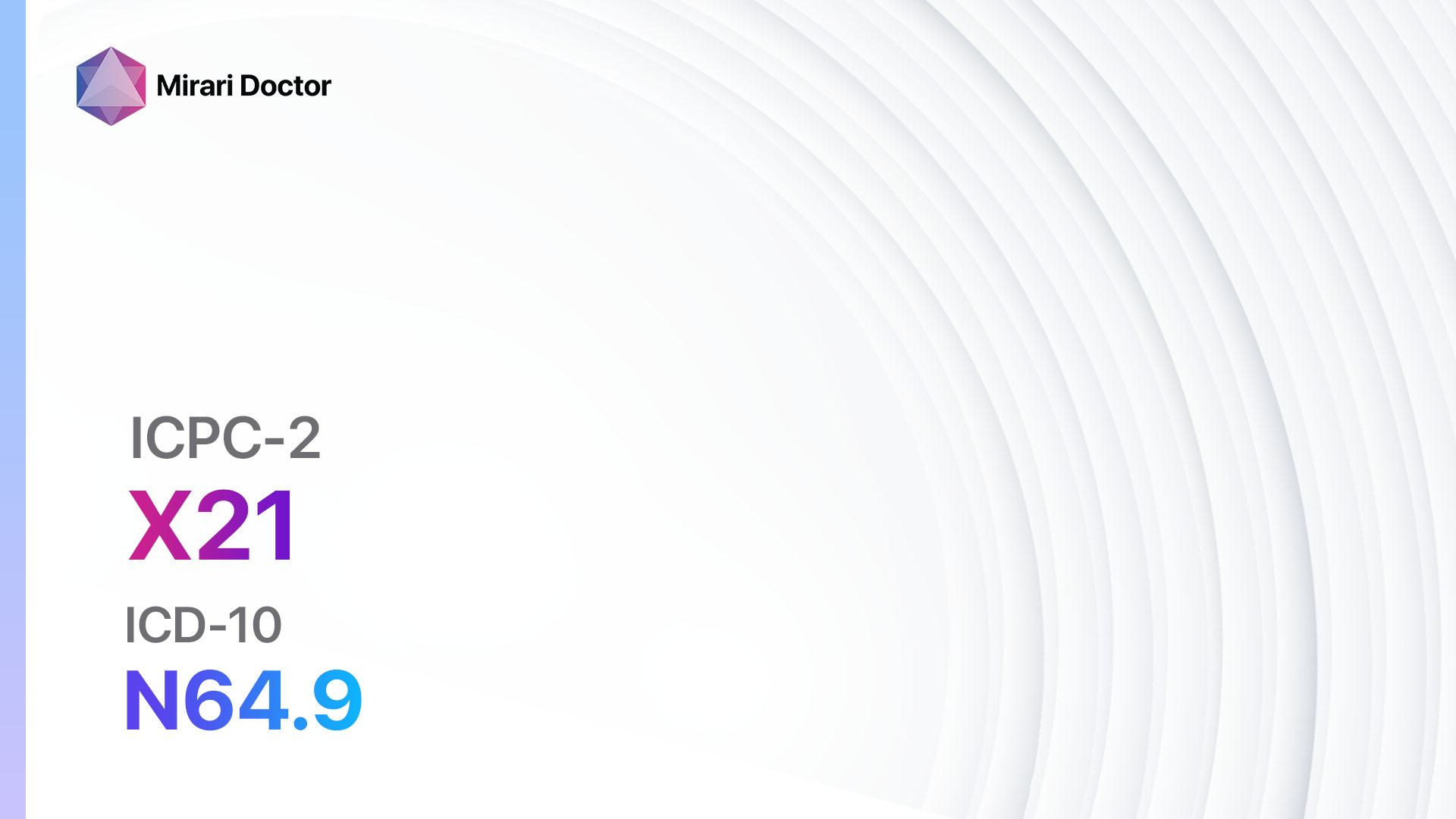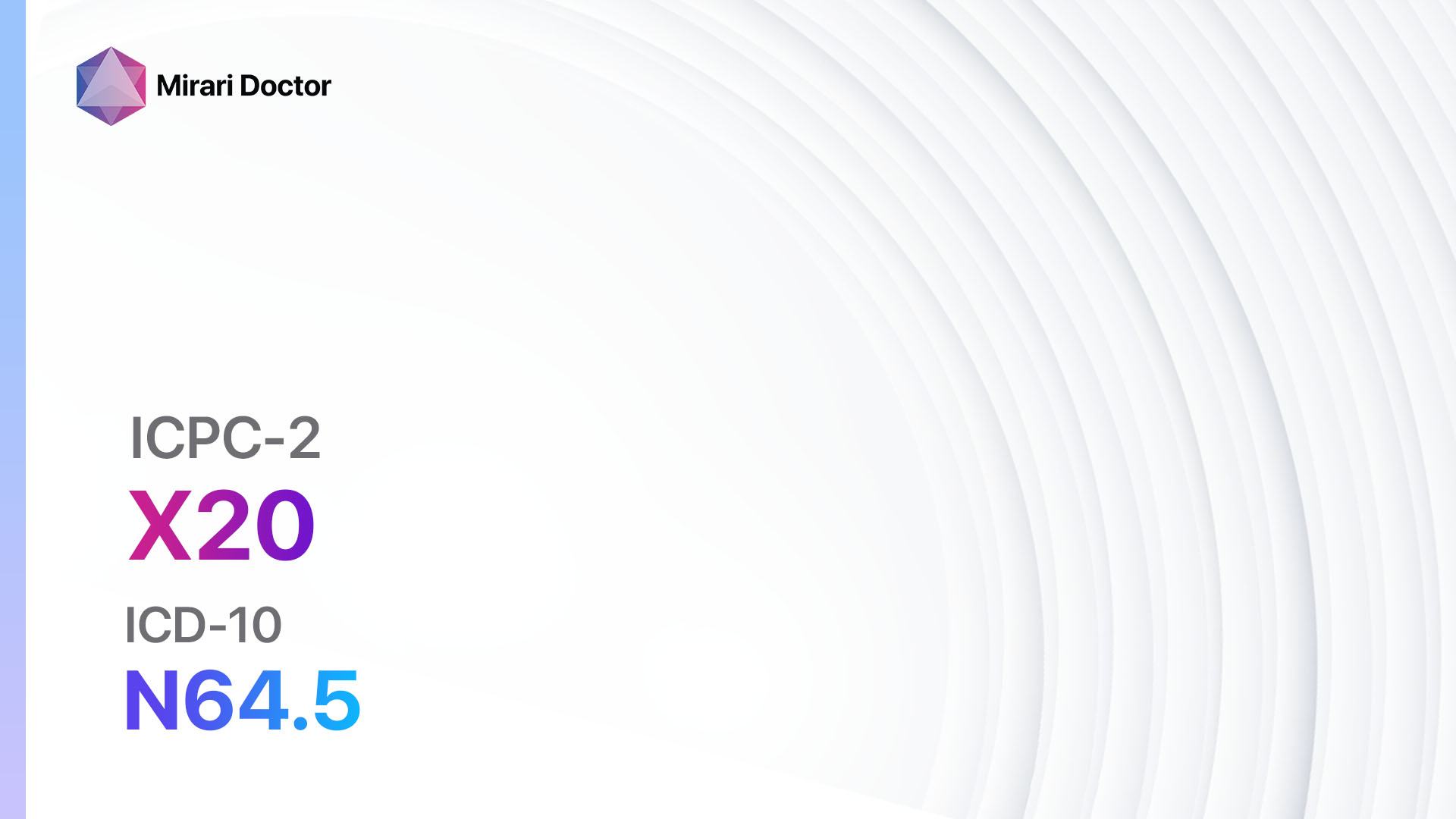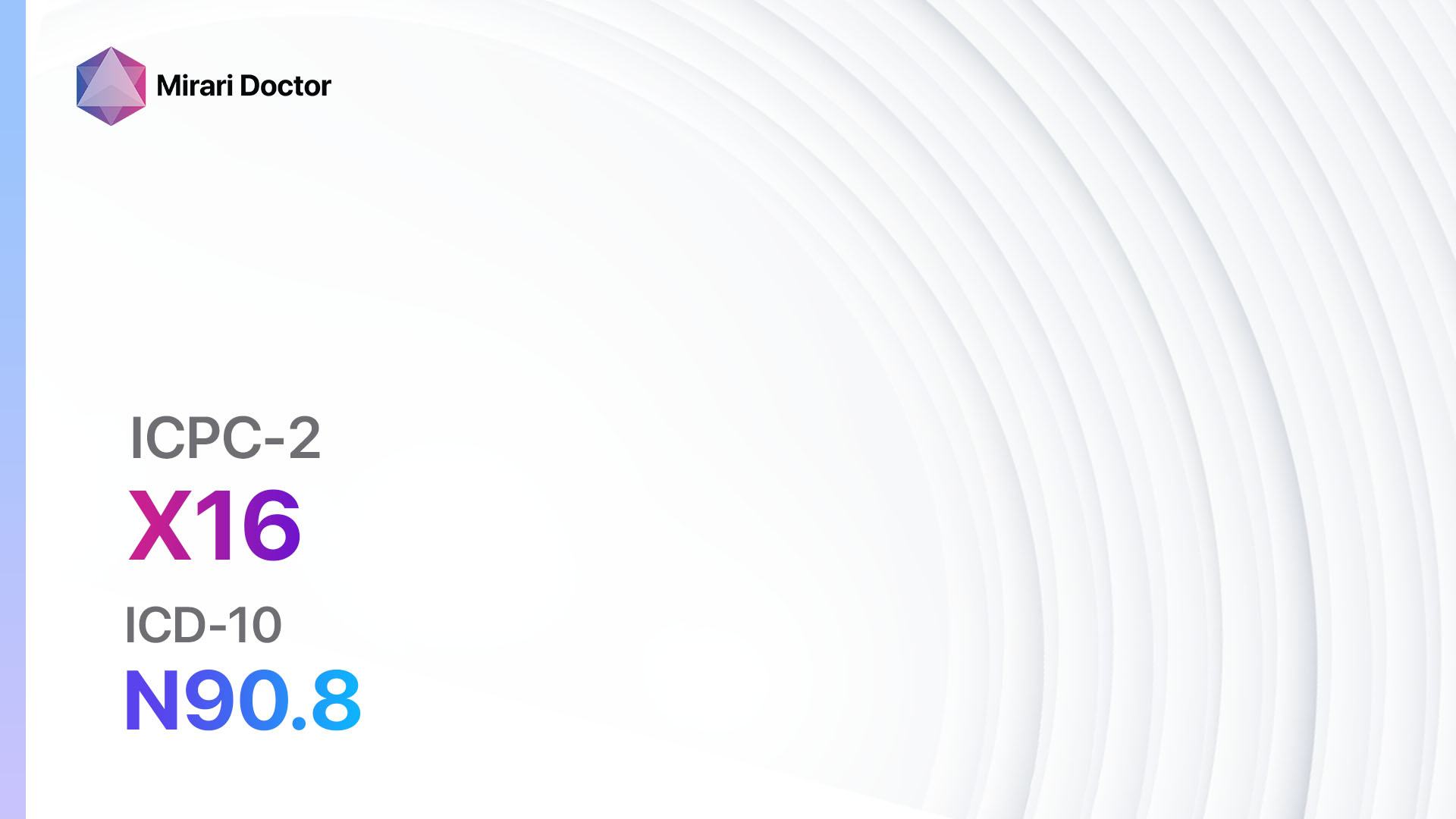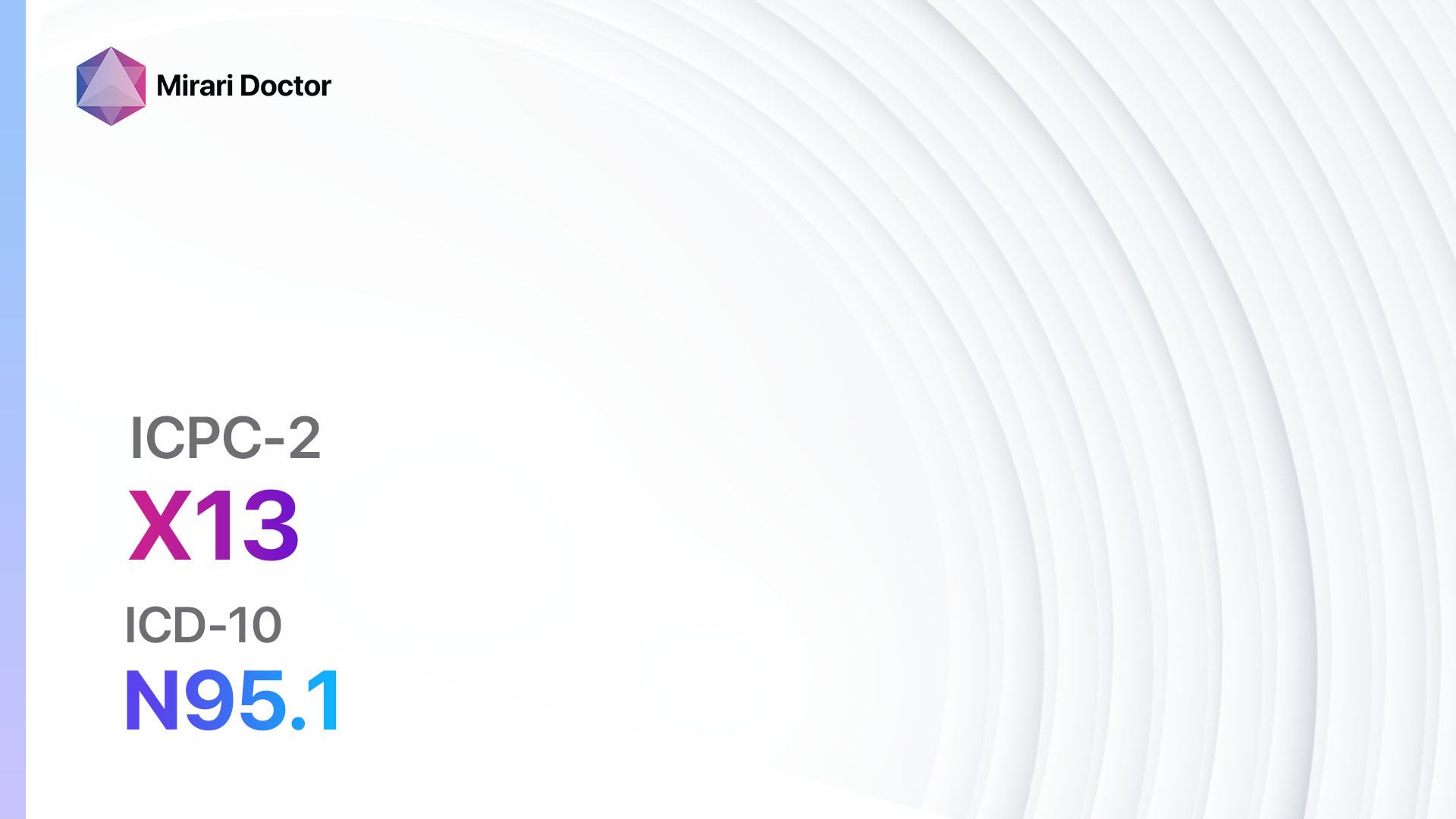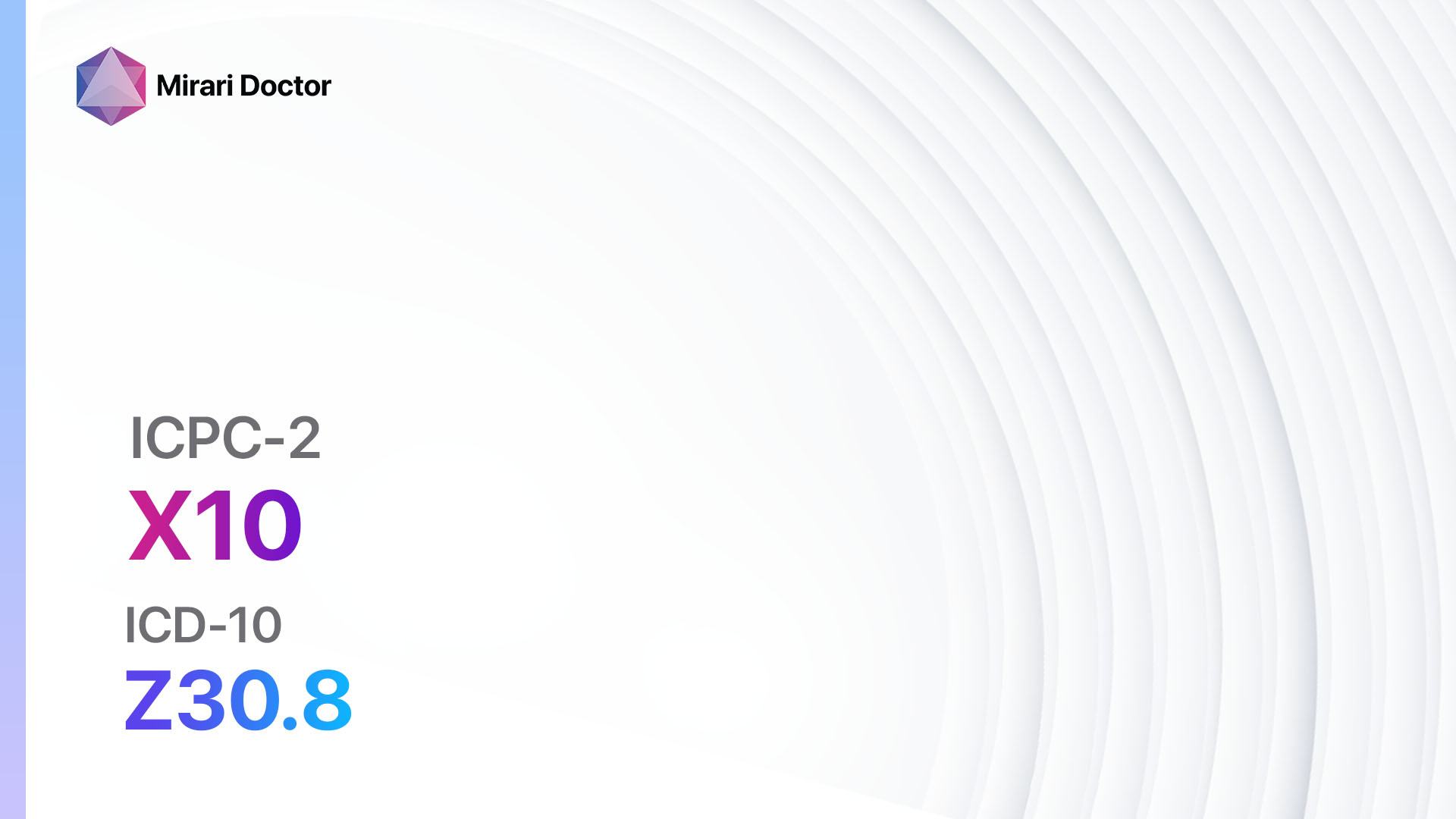
Introduction
Genital neoplasm refers to the abnormal growth of cells in the genital area. It can occur in both males and females, but this guide specifically focuses on genital neoplasms in females. This condition is significant as it can lead to various complications and affect a person’s reproductive health[1]. The aim of this guide is to provide an overview of the symptoms, causes, diagnostic steps, possible interventions, and lifestyle interventions for genital neoplasm in females.
Codes
- ICPC-2 Code: X81 Genital neoplasm female other/unspecified
- ICD-10 Code: D39.9 Neoplasm of uncertain or unknown behaviour of female genital organ, unspecified
Symptoms
- Abnormal vaginal bleeding[2]
- Vaginal discharge[3]
- Pelvic pain or discomfort[4]
- Itching or irritation in the genital area[5]
- Changes in the appearance of the vulva or vagina[6]
Causes
- Human papillomavirus (HPV) infection[7]
- Genetic factors[8]
- Hormonal imbalances[9]
- Smoking[10]
- Weakened immune system
Diagnostic Steps
Medical History
- Gather information about the patient’s risk factors, such as HPV infection, smoking, or family history of genital neoplasms.
- Inquire about any medical conditions or medications that may increase the risk of developing genital neoplasms.
- Ask about the presence of symptoms related to genital neoplasms, such as abnormal vaginal bleeding or pelvic pain.
Physical Examination
- Perform a thorough physical examination of the genital area, including the vulva, vagina, and cervix.
- Look for any visible abnormalities, such as lumps, sores, or changes in color or texture.
- Palpate the pelvic area to check for any masses or enlarged lymph nodes.
Laboratory Tests
- Pap smear: A sample of cells is collected from the cervix and examined under a microscope to detect any abnormal changes.
- HPV DNA test: This test checks for the presence of high-risk HPV strains that are associated with genital neoplasms.
- Biopsy: A small tissue sample is taken from the affected area and examined under a microscope to confirm the diagnosis.
Diagnostic Imaging
- Transvaginal ultrasound: This imaging technique uses sound waves to create images of the pelvic organs and can help identify any abnormalities.
- Magnetic resonance imaging (MRI): MRI scans can provide detailed images of the pelvic area and help determine the extent of the neoplasm.
Other Tests
- Colposcopy: A colposcope is used to examine the cervix, vagina, and vulva in detail. Biopsies may be taken during this procedure.
- Cystoscopy: This procedure involves inserting a thin tube with a camera into the bladder to examine the urethra and bladder for any signs of neoplasms.
- Proctoscopy: A proctoscope is used to examine the rectum and lower part of the colon for any abnormalities.
Follow-up and Patient Education
- Schedule regular follow-up appointments to monitor the progress of the neoplasm and assess the effectiveness of the interventions.
- Provide education to the patient about the importance of regular screenings, such as Pap smears, to detect any recurrence or new neoplasms.
Possible Interventions
Traditional Interventions
Medications:
Top 5 drugs for Genital neoplasm:
- Chemotherapy drugs (e.g., Paclitaxel, Cisplatin):
- Cost: Varies depending on the specific drug and treatment regimen.
- Contraindications: Allergy to the drug, severe kidney or liver disease.
- Side effects: Nausea, vomiting, hair loss, fatigue.
- Severe side effects: Bone marrow suppression, kidney damage, nerve damage.
- Drug interactions: Many potential drug interactions, so careful monitoring is required.
- Warning: Regular blood tests and close monitoring of side effects are necessary.
- Hormonal therapy (e.g., Tamoxifen, Aromatase inhibitors):
- Cost: Varies depending on the specific drug and treatment regimen.
- Contraindications: Pregnancy, history of blood clots.
- Side effects: Hot flashes, mood changes, vaginal dryness.
- Severe side effects: Increased risk of uterine cancer, blood clots.
- Drug interactions: Many potential drug interactions, so careful monitoring is required.
- Warning: Regular monitoring of hormone levels and side effects is necessary.
- Immunotherapy (e.g., Pembrolizumab, Nivolumab):
- Cost: Varies depending on the specific drug and treatment regimen.
- Contraindications: Allergy to the drug, autoimmune disorders.
- Side effects: Fatigue, skin rash, diarrhea.
- Severe side effects: Severe allergic reactions, inflammation of organs.
- Drug interactions: Many potential drug interactions, so careful monitoring is required.
- Warning: Regular monitoring of immune function and side effects is necessary.
- Targeted therapy (e.g., Trastuzumab, Bevacizumab):
- Cost: Varies depending on the specific drug and treatment regimen.
- Contraindications: Allergy to the drug, severe heart disease.
- Side effects: Fatigue, nausea, high blood pressure.
- Severe side effects: Heart damage, bleeding, impaired wound healing.
- Drug interactions: Many potential drug interactions, so careful monitoring is required.
- Warning: Regular monitoring of heart function and side effects is necessary.
- Radiation therapy:
- Cost: Varies depending on the specific treatment regimen and duration.
- Contraindications: Pregnancy, severe kidney or liver disease.
- Side effects: Fatigue, skin changes, nausea.
- Severe side effects: Damage to nearby organs, secondary cancers.
- Drug interactions: None.
- Warning: Regular monitoring of side effects and follow-up appointments are necessary.
Alternative Drugs:
- Herbal supplements: Some herbal supplements, such as green tea extract or curcumin, may have potential benefits in reducing inflammation and supporting the immune system. Cost: Varies depending on the specific supplement.
Surgical Procedures
- Surgical excision: The neoplasm is surgically removed, along with a margin of healthy tissue. Cost: Varies depending on the complexity of the procedure and hospital charges.
- Lymph node dissection: Lymph nodes in the pelvic area are surgically removed and examined for the presence of cancer cells. Cost: Varies depending on the complexity of the procedure and hospital charges.
Alternative Interventions
- Acupuncture: May help manage pain and improve overall well-being. Cost: $60-$120 per session.
- Mind-body techniques: Practices such as meditation, yoga, or guided imagery may help reduce stress and improve quality of life. Cost: Varies depending on the specific program or instructor.
- Nutritional therapy: A balanced diet rich in fruits, vegetables, and whole grains can support the immune system and overall health. Cost: Varies depending on individual food choices.
- Supportive care: Counseling, support groups, or therapy can provide emotional support and help cope with the challenges of living with genital neoplasms. Cost: Varies depending on the specific service or provider.
Lifestyle Interventions
- Smoking cessation: Quitting smoking can reduce the risk of developing genital neoplasms and improve overall health. Cost: Varies depending on the chosen method (e.g., nicotine replacement therapy, counseling).
- Healthy diet: Consuming a balanced diet rich in fruits, vegetables, whole grains, and lean proteins can support overall health and strengthen the immune system. Cost: Varies depending on individual food choices.
- Regular exercise: Engaging in regular physical activity can improve overall well-being and reduce the risk of developing chronic diseases. Cost: Varies depending on the chosen activity (e.g., gym membership, home workout equipment).
- Stress management: Practicing stress-reducing techniques, such as meditation, deep breathing exercises, or mindfulness, can help improve quality of life. Cost: Varies depending on the chosen method (e.g., self-guided techniques, attending classes or workshops).
It is important to note that the cost ranges provided are approximate and may vary depending on the location and availability of the interventions. It is recommended to consult with healthcare professionals for personalized treatment options and cost estimates.
Mirari Cold Plasma Alternative Intervention
Understanding Mirari Cold Plasma
- Safe and Non-Invasive Treatment: Mirari Cold Plasma is a safe and non-invasive treatment option for various skin conditions. It does not require incisions, minimizing the risk of scarring, bleeding, or tissue damage.
- Efficient Extraction of Foreign Bodies: Mirari Cold Plasma facilitates the removal of foreign bodies from the skin by degrading and dissociating organic matter, allowing easier access and extraction.
- Pain Reduction and Comfort: Mirari Cold Plasma has a local analgesic effect, providing pain relief during the treatment, making it more comfortable for the patient.
- Reduced Risk of Infection: Mirari Cold Plasma has antimicrobial properties, effectively killing bacteria and reducing the risk of infection.
- Accelerated Healing and Minimal Scarring: Mirari Cold Plasma stimulates wound healing and tissue regeneration, reducing healing time and minimizing the formation of scars.
Mirari Cold Plasma Prescription
Video instructions for using Mirari Cold Plasma Device – X81 Genital neoplasm female other/unspecified (ICD-10:D39.9)
| Mild | Moderate | Severe |
| Mode setting: 1 (Infection) Location: 0 (Localized) Morning: 15 minutes, Evening: 15 minutes |
Mode setting: 1 (Infection) Location: 0 (Localized) Morning: 30 minutes, Lunch: 30 minutes, Evening: 30 minutes |
Mode setting: 1 (Infection) Location: 0 (Localized) Morning: 30 minutes, Lunch: 30 minutes, Evening: 30 minutes |
| Mode setting: 2 (Wound Healing) Location: 0 (Localized) Morning: 15 minutes, Evening: 15 minutes |
Mode setting: 2 (Wound Healing) Location: 0 (Localized) Morning: 30 minutes, Lunch: 30 minutes, Evening: 30 minutes |
Mode setting: 2 (Wound Healing) Location: 0 (Localized) Morning: 30 minutes, Lunch: 30 minutes, Evening: 30 minutes |
| Mode setting: 3 (Antiviral Therapy) Location: 0 (Localized) Morning: 15 minutes, Evening: 15 minutes |
Mode setting: 3 (Antiviral Therapy) Location: 0 (Localized) Morning: 30 minutes, Lunch: 30 minutes, Evening: 30 minutes |
Mode setting: 3 (Antiviral Therapy) Location: 0 (Localized) Morning: 30 minutes, Lunch: 30 minutes, Evening: 30 minutes |
| Mode setting: 7 (Immunotherapy) Location: 1 (Sacrum) Morning: 15 minutes, Evening: 15 minutes |
Mode setting: 7 (Immunotherapy) Location: 1 (Sacrum) Morning: 30 minutes, Lunch: 30 minutes, Evening: 30 minutes |
Mode setting: 7 (Immunotherapy) Location: 1 (Sacrum) Morning: 30 minutes, Lunch: 30 minutes, Evening: 30 minutes |
| Total Morning: 60 minutes approx. $10 USD, Evening: 60 minutes approx. $10 USD |
Total Morning: 120 minutes approx. $20 USD, Lunch: 120 minutes approx. $20 USD, Evening: 120 minutes approx. $20 USD, |
Total Morning: 120 minutes approx. $20 USD, Lunch: 120 minutes approx. $20 USD, Evening: 120 minutes approx. $20 USD, |
| Usual treatment for 7-60 days approx. $140 USD – $1200 USD | Usual treatment for 6-8 weeks approx. $2,520 USD – $3,360 USD |
Usual treatment for 3-6 months approx. $5,400 USD – $10,800 USD
|
 |
|
Use the Mirari Cold Plasma device to treat Genital neoplasm oth/unspecied (f) effectively.
WARNING: MIRARI COLD PLASMA IS DESIGNED FOR THE HUMAN BODY WITHOUT ANY ARTIFICIAL OR THIRD PARTY PRODUCTS. USE OF OTHER PRODUCTS IN COMBINATION WITH MIRARI COLD PLASMA MAY CAUSE UNPREDICTABLE EFFECTS, HARM OR INJURY. PLEASE CONSULT A MEDICAL PROFESSIONAL BEFORE COMBINING ANY OTHER PRODUCTS WITH USE OF MIRARI.
Step 1: Cleanse the Skin
- Start by cleaning the affected area of the skin with a gentle cleanser or mild soap and water. Gently pat the area dry with a clean towel.
Step 2: Prepare the Mirari Cold Plasma device
- Ensure that the Mirari Cold Plasma device is fully charged or has fresh batteries as per the manufacturer’s instructions. Make sure the device is clean and in good working condition.
- Switch on the Mirari device using the power button or by following the specific instructions provided with the device.
- Some Mirari devices may have adjustable settings for intensity or treatment duration. Follow the manufacturer’s instructions to select the appropriate settings based on your needs and the recommended guidelines.
Step 3: Apply the Device
- Place the Mirari device in direct contact with the affected area of the skin. Gently glide or hold the device over the skin surface, ensuring even coverage of the area experiencing.
- Slowly move the Mirari device in a circular motion or follow a specific pattern as indicated in the user manual. This helps ensure thorough treatment coverage.
Step 4: Monitor and Assess:
- Keep track of your progress and evaluate the effectiveness of the Mirari device in managing your Genital neoplasm oth/unspecied (f). If you have any concerns or notice any adverse reactions, consult with your health care professional.
Note
This guide is for informational purposes only and should not replace the advice of a medical professional. Always consult with your healthcare provider or a qualified medical professional for personal advice, diagnosis, or treatment. Do not solely rely on the information presented here for decisions about your health. Use of this information is at your own risk. The authors of this guide, nor any associated entities or platforms, are not responsible for any potential adverse effects or outcomes based on the content.
Mirari Cold Plasma System Disclaimer
- Purpose: The Mirari Cold Plasma System is a Class 2 medical device designed for use by trained healthcare professionals. It is registered for use in Thailand and Vietnam. It is not intended for use outside of these locations.
- Informational Use: The content and information provided with the device are for educational and informational purposes only. They are not a substitute for professional medical advice or care.
- Variable Outcomes: While the device is approved for specific uses, individual outcomes can differ. We do not assert or guarantee specific medical outcomes.
- Consultation: Prior to utilizing the device or making decisions based on its content, it is essential to consult with a Certified Mirari Tele-Therapist and your medical healthcare provider regarding specific protocols.
- Liability: By using this device, users are acknowledging and accepting all potential risks. Neither the manufacturer nor the distributor will be held accountable for any adverse reactions, injuries, or damages stemming from its use.
- Geographical Availability: This device has received approval for designated purposes by the Thai and Vietnam FDA. As of now, outside of Thailand and Vietnam, the Mirari Cold Plasma System is not available for purchase or use.
References
- Vaginal cancer – Symptoms and causes – Mayo Clinic. (n.d.). Retrieved from https://www.mayoclinic.org/diseases-conditions/vaginal-cancer/symptoms-causes/syc-20352447
- Vaginal Neoplasms (Vaginal Tumors and Cancer) – Healthline. (n.d.). Retrieved from https://www.healthline.com/health/vaginal-tumors
- Symptoms of vaginal cancer – NHS. (n.d.). Retrieved from https://www.nhs.uk/conditions/vaginal-cancer/symptoms/
- Pelvic pain in gynecological cancer – Vinmec. (n.d.). Retrieved from https://www.vinmec.com/en/oncology-radiotherapy/medicine-information/pelvic-pain-in-gynecological-cancer/
- Vaginal Cancer: Causes, Symptoms, Types & Treatment. (n.d.). Retrieved from https://my.clevelandclinic.org/health/diseases/15579-vaginal-cancer
- Human papillomavirus and cancer – World Health Organization (WHO). (n.d.). Retrieved from https://www.who.int/news-room/fact-sheets/detail/human-papilloma-virus-and-cancer
- [Anogenital HPV Infection as the Potential Risk Factor for … – PubMed. (n.d.). Retrieved from https://pubmed.ncbi.nlm.nih.gov/29708352/
- Genetics of Breast and Gynecologic Cancers (PDQ®) – NCBI. (n.d.). Retrieved from https://www.ncbi.nlm.nih.gov/books/NBK65767/
- Vaginal cancer – Diagnosis and treatment – Mayo Clinic. (n.d.). Retrieved from https://www.mayoclinic.org/diseases-conditions/vaginal-cancer/diagnosis-treatment/drc-20352453
- Vaginal Cancer – American Cancer Society. (n.d.). Retrieved from https://www.cancer.org/cancer/types/vaginal-cancer/references.html
Related articles
Made in USA














